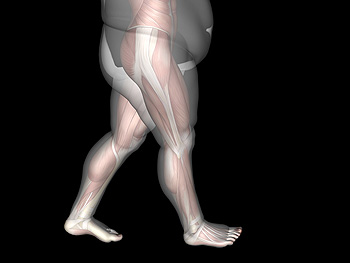September 2019
Why Live with Pain and Numbness in Your Feet?
Washington Baseman Deals with Plantar Fasciitis Recovery
 First baseman Ryan Zimmerman of the Washington Nationals has suffered a “brutal” season due to plantar fasciitis in his right foot. The condition made Zimmerman’s returns to the field slow. The nature of the athlete’s injury has also made it slow to heal; fully torn plantar fascia are faster to heal, but Zimmerman’s fascia was only partly torn. Before his return on September 1st, Zimmerman rehabilitated on the treadmill. Plantar fasciitis is a common sports injury that can be disruptive to everyday life. If you think you’ve sustained a plantar fasciitis injury, contact your podiatrist.
First baseman Ryan Zimmerman of the Washington Nationals has suffered a “brutal” season due to plantar fasciitis in his right foot. The condition made Zimmerman’s returns to the field slow. The nature of the athlete’s injury has also made it slow to heal; fully torn plantar fascia are faster to heal, but Zimmerman’s fascia was only partly torn. Before his return on September 1st, Zimmerman rehabilitated on the treadmill. Plantar fasciitis is a common sports injury that can be disruptive to everyday life. If you think you’ve sustained a plantar fasciitis injury, contact your podiatrist.
Plantar fasciitis is a common foot condition that is often caused by a strain injury. If you are experiencing heel pain or symptoms of plantar fasciitis, contact Dr. Craig Campbell from Salt Lake City, Utah. Our doctor can provide the care you need to keep you pain-free and on your feet.
What Is Plantar Fasciitis?
Plantar fasciitis is one of the most common causes of heel pain. The plantar fascia is a ligament that connects your heel to the front of your foot. When this ligament becomes inflamed, plantar fasciitis is the result. If you have plantar fasciitis you will have a stabbing pain that usually occurs with your first steps in the morning. As the day progresses and you walk around more, this pain will start to disappear, but it will return after long periods of standing or sitting.
What Causes Plantar Fasciitis?
- Excessive running
- Having high arches in your feet
- Other foot issues such as flat feet
- Pregnancy (due to the sudden weight gain)
- Being on your feet very often
There are some risk factors that may make you more likely to develop plantar fasciitis compared to others. The condition most commonly affects adults between the ages of 40 and 60. It also tends to affect people who are obese because the extra pounds result in extra stress being placed on the plantar fascia.
Prevention
- Take good care of your feet – Wear shoes that have good arch support and heel cushioning.
- Maintain a healthy weight
- If you are a runner, alternate running with other sports that won’t cause heel pain
There are a variety of treatment options available for plantar fasciitis along with the pain that accompanies it. Additionally, physical therapy is a very important component in the treatment process. It is important that you meet with your podiatrist to determine which treatment option is best for you.
If you have any questions, please feel free to contact our office located in Salt Lake City, UT. We offer the newest diagnostic and treatment technologies for all your foot care needs.
Read more about Plantar Fasciitis
Is Being Overweight Detrimental to the Health of the Feet?
 Patients who are overweight may notice they frequently experience foot pain. This can be a result of the added weight the feet must endure on a daily basis. Additionally, there are uncomfortable foot conditions that may develop which can include plantar fasciitis, arthritis, and tendinitis. These can compromise the ability to complete daily activities. Obese patients may have flat feet, and this may produce considerable pain and discomfort. Other medical conditions that can develop from being overweight are gout, diabetes, and circulation ailments. If you have questions about how obesity can affect the feet, it is strongly advised that you seek the counsel of a podiatrist.
Patients who are overweight may notice they frequently experience foot pain. This can be a result of the added weight the feet must endure on a daily basis. Additionally, there are uncomfortable foot conditions that may develop which can include plantar fasciitis, arthritis, and tendinitis. These can compromise the ability to complete daily activities. Obese patients may have flat feet, and this may produce considerable pain and discomfort. Other medical conditions that can develop from being overweight are gout, diabetes, and circulation ailments. If you have questions about how obesity can affect the feet, it is strongly advised that you seek the counsel of a podiatrist.
The more you weigh, the harder your feet must work to support your body. If you’re an obese individual and are concerned about your feet, contact Dr. Craig Campbell from Salt Lake City, Utah. Our doctor can provide the care you need to keep you pain-free and on your feet.
Obesity and Your Feet
People who are overweight are putting more pressure on their ankles, knees, and hips as well as their feet. This unfortunately can lead to variety of different issues.
Problems & Complications Stemming from Obesity
- When the body is overweight, it tries to compensate by changing the way that it moves. An obese person may lean forward and put extra weight on the wrong part of the foot. This puts unnecessary stress on the feet.
- Obese people are also more likely to develop type II diabetes which is a condition that causes a lot of foot problems. People with diabetes often don’t feel the cuts and sores that they may have on their feet, which can lead to more complicated and severe issues.
- Plantar fasciitis is another foot condition that can be caused by obesity. Plantar fasciitis is an inflammation of the tissue along the bottom of the foot, which causes pain and stiffness while walking and climbing stairs.
If you have any questions, please feel free to contact our office located in Salt Lake City, UT. We offer the newest diagnostic and treatment technologies for all your foot care needs.
Read more about Obesity and the FeetPossible Causes of Ankle Sprains
 When your ankle rolls to one side after unexpectedly stepping off of a curb, the pain and discomfort that often accompanies this type of injury can be intense. Many patients have difficulty walking after incurring an ankle injury, and running activities are temporarily impossible to partake in. An ankle sprain typically consists of damaged ligaments that comes from being stretched too far. Common symptoms of an ankle injury often include swelling and throbbing on and around the affected area, severe pain and discomfort while attempting to move it, and it is often tender when touched. Moderate relief can be obtained while elevating the ankle. This may help in diminishing a portion of the swelling. After a proper diagnosis is performed, which typically consists of having an X-ray taken, the ankle will generally be wrapped in an elastic bandage that can provide adequate support. It is strongly advised that you seek the counsel of a podiatrist who can properly treat ankle injuries.
When your ankle rolls to one side after unexpectedly stepping off of a curb, the pain and discomfort that often accompanies this type of injury can be intense. Many patients have difficulty walking after incurring an ankle injury, and running activities are temporarily impossible to partake in. An ankle sprain typically consists of damaged ligaments that comes from being stretched too far. Common symptoms of an ankle injury often include swelling and throbbing on and around the affected area, severe pain and discomfort while attempting to move it, and it is often tender when touched. Moderate relief can be obtained while elevating the ankle. This may help in diminishing a portion of the swelling. After a proper diagnosis is performed, which typically consists of having an X-ray taken, the ankle will generally be wrapped in an elastic bandage that can provide adequate support. It is strongly advised that you seek the counsel of a podiatrist who can properly treat ankle injuries.
Although ankle sprains are common, they aren’t always minor injuries. If you need your ankle injury looked at, contact Dr. Craig Campbell from Salt Lake City, Utah. Our doctor can provide the care you need to keep you pain-free and on your feet.
How Does an Ankle Sprain Occur?
Ankle sprains are the result of a tear in the ligaments within the ankle. These injuries may happen when you make a rapid shifting movement while your foot is planted. A less common way to sprain your ankle is when your ankle rolls inward while your foot turns outward.
What Are the Symptoms?
- Pain at the sight of the tear
- Bruising/Swelling
- Ankle area is tender to touch
- In severe cases, may hear/feel something tear
- Skin discoloration
Preventing a Sprain
- Wearing appropriate shoes for the occasion
- Stretching before exercises and sports
- Knowing your limits
Treatment of a Sprain
In many cases, the RICE method (Rest, Ice, Compression, and Elevate) is used to treat ankle sprains. However, you should see a podiatrist to see which treatment option would work best with your injury. In severe cases, surgery may be required.
It is important to ask your doctor about rehab options after you receive treatment for your injury. Stretching, strength training, and balance exercises may help the ankle heal while also preventing further injury.
If you have any questions, please feel free to contact our office located in Salt Lake City, UT. We offer the newest diagnostic and treatment technologies for all your foot care needs.
Read more about Ankle SprainsWhat Causes Heel Spurs?
 The condition that is known as a heel spur can cause pain and discomfort. It happens as a result of a calcium deposit that forms between the arch and the heel of the foot. The symptoms that are often associated with this condition can include difficulty in walking barefoot, pain in the heel and surrounding areas, and swelling and inflammation. It can develop with muscle and ligament tension, which may cause the soft tissues to wear out. People who frequently participate in sporting activities that involve running and jumping may be prone to developing heel spurs. It is beneficial to wear shoes that have adequate cushioning in the heel area, in addition to resting and elevating the foot as often as possible. If you have developed a heel spur, it is advised that you speak to a podiatrist who can recommend treatment options that are correct for you.
The condition that is known as a heel spur can cause pain and discomfort. It happens as a result of a calcium deposit that forms between the arch and the heel of the foot. The symptoms that are often associated with this condition can include difficulty in walking barefoot, pain in the heel and surrounding areas, and swelling and inflammation. It can develop with muscle and ligament tension, which may cause the soft tissues to wear out. People who frequently participate in sporting activities that involve running and jumping may be prone to developing heel spurs. It is beneficial to wear shoes that have adequate cushioning in the heel area, in addition to resting and elevating the foot as often as possible. If you have developed a heel spur, it is advised that you speak to a podiatrist who can recommend treatment options that are correct for you.
Heel spurs can be incredibly painful and sometimes may make you unable to participate in physical activities. To get medical care for your heel spurs, contact Dr. Craig Campbell from Salt Lake City, Utah. Our doctor will do everything possible to treat your condition.
Heels Spurs
Heel spurs are formed by calcium deposits on the back of the foot where the heel is. This can also be caused by small fragments of bone breaking off one section of the foot, attaching onto the back of the foot. Heel spurs can also be bone growth on the back of the foot and may grow in the direction of the arch of the foot.
Older individuals usually suffer from heel spurs and pain sometimes intensifies with age. One of the main condition's spurs are related to is plantar fasciitis.
Pain
The pain associated with spurs is often because of weight placed on the feet. When someone is walking, their entire weight is concentrated on the feet. Bone spurs then have the tendency to affect other bones and tissues around the foot. As the pain continues, the feet will become tender and sensitive over time.
Treatments
There are many ways to treat heel spurs. If one is suffering from heel spurs in conjunction with pain, there are several methods for healing. Medication, surgery, and herbal care are some options.
If you have any questions feel free to contact our office located in Salt Lake City, UT. We offer the latest in diagnostic and treatment technology to meet your needs.
Read more about Heel Spurs






